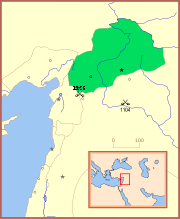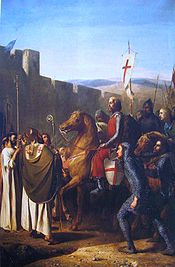
Thoros of Edessa
Encyclopedia

Edessa, Mesopotamia
Edessa is the Greek name of an Aramaic town in northern Mesopotamia, as refounded by Seleucus I Nicator. For the modern history of the city, see Şanlıurfa.-Names:...
at the time of the First Crusade
First Crusade
The First Crusade was a military expedition by Western Christianity to regain the Holy Lands taken in the Muslim conquest of the Levant, ultimately resulting in the recapture of Jerusalem...
.
Thoros was a former officer (curopalates
Curopalates
Kouropalatēs, Latinized as curopalates or curopalata and Anglicized as curopalate, was a Byzantine court title, one of the highest from the time of Emperor Justinian I to that of the Komnenoi in the 12th century...
) in the Byzantine Empire
Byzantine Empire
The Byzantine Empire was the Eastern Roman Empire during the periods of Late Antiquity and the Middle Ages, centred on the capital of Constantinople. Known simply as the Roman Empire or Romania to its inhabitants and neighbours, the Empire was the direct continuation of the Ancient Roman State...
and a lieutenant of Philaretos Brachamios
Philaretos Brachamios
Philaretos Brachamios was a distinguished Byzantine general and warlord of Armenian heritage, and for a time was a usurper against emperor Michael VII...
. He was Armenia
Armenia
Armenia , officially the Republic of Armenia , is a landlocked mountainous country in the Caucasus region of Eurasia...
n but practised the Greek Orthodox
Eastern Orthodox Church
The Orthodox Church, officially called the Orthodox Catholic Church and commonly referred to as the Eastern Orthodox Church, is the second largest Christian denomination in the world, with an estimated 300 million adherents mainly in the countries of Belarus, Bulgaria, Cyprus, Georgia, Greece,...
faith. Steven Runciman calls Thoros the "son-in-law" of Gabriel of Melitene.
Around 1094, the Seljuk emir of Damascus
Damascus
Damascus , commonly known in Syria as Al Sham , and as the City of Jasmine , is the capital and the second largest city of Syria after Aleppo, both are part of the country's 14 governorates. In addition to being one of the oldest continuously inhabited cities in the world, Damascus is a major...
, Tutush I
Tutush I
Abu Sa'id Taj ad-Dawla Tutush I was the Seljuq ruler of Damascus from 1079 to 1095, succeeding Abaaq al-Khwarazmi. He finished the construction of the Citadel of Damascus, a project that had begun under the direction of Abaaq al Khwarizmi...
, captured Edessa and established Thoros as governor. Thoros immediately tried to take control of the city for himself; when Yaghi-Siyan
Yaghi-Siyan
Yaghi-Siyan was the governor of Antioch during the First Crusade.He was a Turkic slave of the Seljuk sultan Malik Shah I, who had captured Antioch in 1085 and appointed Yaghi-Siyan governor around 1090. Malik Shah died in 1092, and his successor Tutush I granted Yaghi-Siyan more territory around...
, emir of Antioch
Antioch
Antioch on the Orontes was an ancient city on the eastern side of the Orontes River. It is near the modern city of Antakya, Turkey.Founded near the end of the 4th century BC by Seleucus I Nicator, one of Alexander the Great's generals, Antioch eventually rivaled Alexandria as the chief city of the...
, and Ridwan, emir of Aleppo, took refuge in Edessa after being defeated by Malik Shah I
Malik Shah I
Jalāl al-Dawlah Malik-shāh was born in 1055, succeeded Alp Arslan as the Seljuq Sultan in 1072, and reigned until his death in 1092....
, Thoros tried to take them captive and ransom them. The other Edessan nobles did not agree with this and they were freed. Thoros then fortified Edessa and cut off the citadel, garrisoned by Turkish and Armenian troops. The Turks and Ortoqids besieged the city for two months, but were unable to capture it even after breaking through the walls. The Turks withdrew and Thoros was recognized as lord of the city.
As a Greek Orthodox Christian, he was not well-loved by his Armenian subjects in Edessa. He resisted attacks from the Seljuks, but in 1098 had to ask for help from the crusaders, who were occupied at the siege of Antioch
Siege of Antioch
The Siege of Antioch took place during the First Crusade in 1097 and 1098. The first siege, by the crusaders against the Muslim city, lasted from October 21, 1097, to June 2, 1098. The second siege, against the crusaders who had occupied it, lasted from June 7 to June 28, 1098.-Background:Antioch...
.

Baldwin I of Jerusalem
Baldwin I of Jerusalem, formerly Baldwin I of Edessa, born Baldwin of Boulogne , 1058? – 2 April 1118, was one of the leaders of the First Crusade, who became the first Count of Edessa and then the second ruler and first titled King of Jerusalem...
had come to Edessa rather than participate in the siege, probably looking to carve out some territory for himself, and had captured Turbessel. Thoros invited him to Edessa and made an alliance with him in February of 1098. Baldwin gradually convinced Thoros to adopt him as his son and heir, but having done this, Baldwin attacked Thoros' officers and besieged him in the citadel. Thoros agreed to let him have the city and made plans to flee with his family to Melitene, but shortly afterwards, on March 9, Thoros was assassinated
Assassination
To carry out an assassination is "to murder by a sudden and/or secret attack, often for political reasons." Alternatively, assassination may be defined as "the act of deliberately killing someone, especially a public figure, usually for hire or for political reasons."An assassination may be...
by the Armenian inhabitants of the city, possibly at Baldwin's command, and Baldwin became the first count of Edessa
County of Edessa
The County of Edessa was one of the Crusader states in the 12th century, based around Edessa, a city with an ancient history and an early tradition of Christianity....
.
Sources
- Steven RuncimanSteven RuncimanThe Hon. Sir James Cochran Stevenson Runciman CH — known as Steven Runciman — was a British historian known for his work on the Middle Ages...
, A History of the Crusades, vol. I: The First Crusade and the Foundation of the Kingdom of Jerusalem. Cambridge University PressCambridge University PressCambridge University Press is the publishing business of the University of Cambridge. Granted letters patent by Henry VIII in 1534, it is the world's oldest publishing house, and the second largest university press in the world...
, 1951. - Armenia and the Crusades, Tenth to Twelfth Centuries: The Chronicle of Matthew of EdessaMatthew of EdessaMatthew of Edessa was an Armenian historian in the 12th century from the city of Edessa . Matthew was the superior abbot of Karmir Vank' , near the town of Kessoun, east of Marash , the former seat of Baldwin of Boulogne...
. Translated by Ara Edmond Dostourian. National Association for Armenian Studies and Research, 1993. - Fulcher of ChartresFulcher of ChartresFulcher of Chartres was a chronicler of the First Crusade. He wrote in Latin.- Life :His appointment as chaplain of Baldwin of Boulogne in 1097 suggests that he had been trained as a priest, most likely at the school in Chartres...
, A History of the Expedition to Jerusalem, 1095-1127, trans. Frances Rita Ryan. University of Tennessee Press, 1969.

